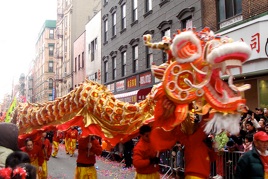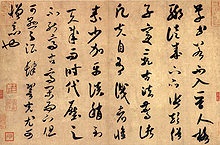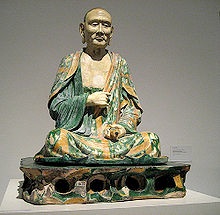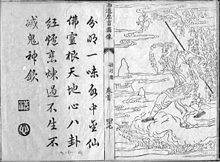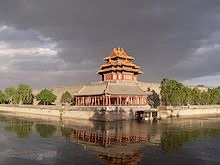Chinese culture

Identity
Today there are 56 distinct recognized ethnic groups in China.[3] In terms of numbers, however, the pre-eminent ethnic group is the Han Chinese. Throughout history, many groups have been assimilated into neighboring ethnicities or disappeared without a trace. At the same time, many within the Han identity have maintained distinct linguistic and regional cultural traditions. The term Zhonghua Minzu has been used to describe the notion of Chinese nationalism in general. Much of the traditional cultural identity within the community has to do with distinguishing the family name.
[edit]
Regional
Main article: Three ancestral treasures
Traditional Chinese Culture covers large geographical territories, where each region is usually divided into distinct sub-cultures. Each region is often represented by three ancestral items. For example Guangdong is represented by chenpi, aged ginger and hay.[4][5] Others include ancient cities like Lin'an (Hangzhou), which include tea leaf, bamboo shoot trunk and hickory nut.[6]
[edit]
Values
Main articles: Chinese philosophy and Religion in China
Most social values are derived from Confucianism and Taoism. The subject of which school was the most influential is always debated as many concepts such as Neo-Confucianism, Buddhism and many others have come about. Reincarnation and other rebirth concept is a reminder of the connection between real-life and the after-life. In Chinese business culture, the concept of guanxi, indicating the primacy of relations over rules, has been well documented.[8]
[edit]
Language
Chinese calligraphy written by Song Dynasty (1051-1108 CE) poet Mi Fu
Main articles: Chinese language and History of Standard Mandarin
The first 4,000 years of Spoken Chinese encompassed both Old Chinese and Middle Chinese, after which it began to split into various dialects and languages about 1,000 years ago. In the Ming Dynasty standard Mandarin was nationalized. Even so, it wasn't until the Republic of China era in the 1900s when there was any noticeable result in promoting a common unified language in China.
The ancient written standard was Classical Chinese. It was used for thousands of years, but was mostly reserved for scholars and intellectuals. By the 20th century, millions of citizens, especially those outside of the imperial court were illiterate[7]. Only after the May 4th Movement did the push for Vernacular Chinese begin. This allowed common citizens to read since it was modeled after the linguistics and phonology of a spoken language.
[edit]
Mythology and spirituality
A Luohan, one of the spiritual figures shared between Chinese and Indian culture across different types of Buddhism.
Sūn Wùkōng in Journey to the West
Main articles: Chinese spiritual world concepts, Chinese mythology, and Chinese folk religion
Chinese religion was originally oriented to worshipping the supreme god Shang Di during the Xia and Shang dynasties, with the king and diviners acting as priests and using oracle bones. The Zhou dynasty oriented it to worshipping the broader concept of heaven. A large part of Chinese culture is based on the notion that a spiritual world exists. Countless methods of divination have helped answer questions, even serving as an alternate to medicine. Folklores have helped fill the gap for things that cannot be explained. There is often a blurred line between myth, religion and unexplained phenomenon. While many deities are part of the tradition, some of the most recognized holy figures include Guan Yin, Jade Emperor and Buddha. Many of the stories have since evolved into traditional Chinese holidays. Other concepts have extended to outside of mythology into spiritual symbols such as Door god and the Imperial guardian lions. Along with the belief of the holy, there is also the evil. Practices such as Taoist exorcism fighting mogwai and jiang shi with peachwood swords are just some of the concepts passed down from generations. A few Chinese fortune telling rituals are still in use today after thousands of years of refinement.
[edit]
Literature
Main article: Chinese literature
Chinese literature began with record keeping and divination on Oracle Bones. The extensive collection of books that have been preserved since the Zhou Dynasty demonstrate just how advanced the intellectuals were at one time. Indeed, the era of the Zhou Dynasty is often looked to as the touchstone of Chinese cultural development. The Five Cardinal Points are the foundation for almost all major studies. Concepts covered within the Chinese classic texts present a wide range of subjects including poetry, astrology, astronomy, calendar, constellations and many others. Some of the most important early texts include I Ching and Shujing within the Four Books and Five Classics. Many Chinese concepts such as Yin and Yang, Qi, Four Pillars of Destiny in relation to heaven and earth were all theorized in the dynastic periods.
Notable confucianists, taoists and scholars of all classes have made significant contributions to and from documenting history to authoring saintly concepts that seem hundred of years ahead of time. Many novels such as Four Great Classical Novels spawned countless fictional stories. By the end of the Qing Dynasty, Chinese culture would embark on a new era with Vernacular Chinese for the common citizens. Hu Shih and Lu Xun would be pioneers in modern literature.
[edit]
Martial arts
China is one of the main birth places of Eastern martial arts. The names of martial arts were called Kung Fu or its first name Wushu. China also includes the home to the well-respected Shaolin Monastery and Wudang Mountains. The first generation of these martial arts started more for the purpose of survival and warfare than art and mastery. Over time, some art forms have branched off, while others have retained a distinct Chinese ways and traditions. however, China has produced some of the most renowned martial artists including kung fu and many others. The arts have also co-existed with a variety of weapons including the more standard 18 arms. Legendary and controversial moves are also praised and talked about within the culture. some cultures associate martial arts as a life style too.
[edit]
Fashion
Men and women in xuanduan formal wear at a Confucian ceremony in China
A north corner of Forbidden City, featuring classic construction style
Main article: Clothing of China
Different social classes in different eras boast different fashion trends, the color yellow is usually reserved for the emperor. China's fashion history covers hundreds of years with some of the most colorful and diverse arrangements. During the Qing Dynasty, China's last imperial dynasty dramatic shift of clothing occurred, the clothing of the era before the Qing Dynasty is reffered to as Hanfu or traditional Han Chinese clothing. Many symbols such as phoenix have been used for decorative as well as economic purposes.
[edit]
[edit]
Cuisine
The overwhelmingly large variety mainly comes from the emperors hosting a banquet of 100 dishes each meal[9]. A countless number of imperial kitchen staff and concubines(women who lived with men but had lower status than them or their wife or wives) were involved in the food preparation process. Over time, many dishes became part of the everyday-citizen culture. Some of the highest quality restaurants with recipes close to the dynastic periods include Fangshan restaurant in Beihai Park Beijing and the Oriole Pavilion[9]. Arguably all branches of Hong Kong eastern style or even American Chinese food are in some ways rooted from the original dynastic cuisines.
[edit]
Leisure
A lot of games and pastimes are popular within Chinese culture. The most common game is Mah Jong. The same pieces are used for other styled games such as Shanghai Solitaire. Weiqi and Xiangqi are also popular. Ethnic games like Chinese yo-yo are also part of the culture.

